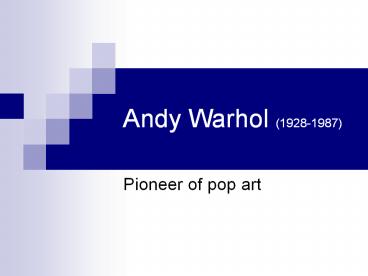Andy Warhol (1928-1987) - PowerPoint PPT Presentation
1 / 9
Title:
Andy Warhol (1928-1987)
Description:
Andy Warhol (1928-1987) Pioneer of pop art Andy Warhol was an American artist who created work known as pop art. After a successful career as a commercial illustrator ... – PowerPoint PPT presentation
Number of Views:295
Avg rating:3.0/5.0
Title: Andy Warhol (1928-1987)
1
Andy Warhol (1928-1987)
- Pioneer of pop art
2
Andy Warhol was an American artist who created
work known as pop art. After a successful career
as a commercial illustrator, Warhol became famous
worldwide for his work as a painter, a film
maker, a record producer and an author. He also
liked to socialise with Hollywood celebrities. He
is generally acknowledged as one of the most
influential artists of the twentieth century.
3
The name pop art refers to the use of popular
culture images. Popular culture simply means
objects, images, artefacts, literature, music,
and so on of "ordinary" people people just like
you and me.Andy Warhol took ordinary things and
made them into works of art.
4
This is a very famous piece of art by Warhol a
tin of soup!
5
Do you recognise this character?
6
Marilyn Monroe was a huge film star in the 1950s
and 1960s. Warhol painted this picture of her.
7
As with the Mickey Mouse picture, Warhol liked to
take an image and repeat it.
8
Other children have looked at examples of Pop Art
in class, including some of Andy Warhol's work.
The children made their own 'Pop Art' pictures.
This time the subjects were 'The Simpsons' and
'The Muppets
9
Your job today is to create a picture using the
style of pop art. You will need to choose a
character from The Simpsons, Spongebob
Squarepants or another character that represents
what children watch on television today.
- Fold a piece of A4 paper into quarters.
- Draw your picture in one quarter. Using tracing
paper, copy the image into the other 3 quarters. - Colour in each picture using only 4 colours. Make
sure each of the images is a different colour.
Use the handout of the childrens work to help
you.































